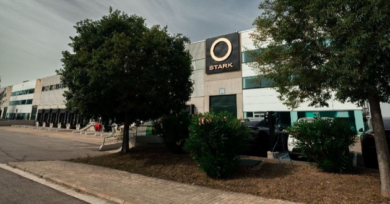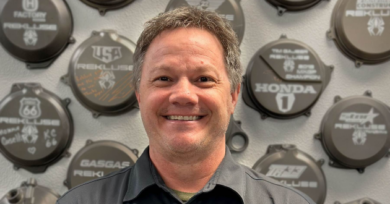Snowmobile companies vary tactics
In the third quarter of 2003, Dick Kellogg, vice president and general manager at Cambridge Metals & Plastics, Cambridge, Minn., noticed that scrap steel prices were beginning a cost surge.
Ralph Pribyl, owner of Bottom Line Traction in Maple Lake, Minn., spotted the same trends last November.
It was their first warning sign that steel prices were on a dramatic march up in prices — one that has more than doubled since January 1.
It’s not just steel prices that have jumped up. It’s also aluminum, carbide, plywood, copper and other petroleum-based products that have seen increases. And, once products are ready to go out the door, there’s increased shipping costs.
For companies in the snowmobile business, these rising costs mean implementing various tactics to mitigate the increases. For some it’s a surcharge. For others, it’s a search for internal efficiencies. For others, it’s both.
Cambridge Metals, which makes aftermarket products such as shop dollies and lifts for major distributors, the strategy has taken many steps.
“We absorbed all the increased until March of this year,” Kellogg said. Then, starting in March, items shipped had a surcharge, which was a percentage of the items’ value. Then, on July 1, the company implemented an average 7% price increase on products and eliminated the surcharge.
They were necessary steps. The material costs are more than half the manufacturing costs, Kellogg said. “In addition, all steel suppliers have instituted raw material
surcharges over and about the increase in raw material.”
Surcharges are not unique to Cambridge. In April, Polaris Industries Inc. imposed surcharges on all delivered equipment. Dealers are currently charged an additional $50 per adult vehicle and $25 per youth vehicle. The payment is due upon shipment to the dealers.
“All of the raw material costs are going up very quickly,” said Marlys Knutson, Polaris external relations manager. “We are hoping that the costs will moderate. We are certainly going to monitor the costs on a weekly basis.” The surcharge is not intended as a permanent charge, but a temporary measure to cover the costs.
Neither Yamaha nor Arctic Cat have instituted any surcharges, though the topic has come up at Arctic Cat, said John Tranby, marketing manager at Arctic Cat. Rob Powers, marketing manager for Yamaha, said there will be no changes in Yamaha pricing.
Trailer-maker Triton Corp., Hartford, Wis., is also implementing a surcharge on its products, as well. “We don’t see that changing for this year,” said Rochelle Priesgen, president.
For Priesgen, it’s not just the steel prices (trailer axles) but it’s aluminum (trailer frames), copper (wiring harnesses), and plywood (decking) increases.
“I don’t believe there’s truly a shortage in all these items,” she said, noting that while the steel increases may be more legitimate, it’s also been a way for other commodity vendors to jump on the claimed-shortage bandwagon.
Priesgen said the surcharge is to the distributors, who are likely passing it on to dealers, who are then either passing it on to the customer or taking a lesser profit margin.
She also noted that the company has to be careful on how much of the price increases actually reach the consumer. “At some point, the end consumer can only afford so much,” she said.
“We’re continually trying to find efficiencies, whether
it’s with higher-tech equipment or reduced labor costs,” she said.
Carbide Commodity
The traction industry would be a likely industry to take a giant hit, but both Ralph Pribyl of Bottom Line Traction and Ed Rubel of Roetin Industries, say they’re holding the ship steady. Carbide prices, they both say, are making a bigger wave than steel.
Pribyl, who owns Bottom Line Traction Inc. in Maple Lake, Minn., said that prices for the high-carbon grade of steel he uses in his studs and runners has not made as big of a hike as stainless steel. Carbide prices, he said, are a different story.
Pribyl has seen higher increased costs in carbide costs, which is a tungsten and cobalt mixture.
“Carbide has gone up five different times in last six months,” Pribyl said. “A lot of that is due to fact that it is solely supplied from offshore.”
He’s trying to mitigate the prices as best as possible for his distributors and customers.
“Rather than going across the board with price increases, I’ve increased some items and decreased others, so impact not quite as dramatic,” Pribyl said. He’s also offering a multi-level discount based on volume to minimize the cost increases through volume discounts.
“A few cents more for steel” was not enough for Ed Rubel, vice president of Roetin Industries in Victor, N.Y., to raise the price of his carbide runners or studs.
It was, however, enough to raise the price of the standard steel runner by $1. It may not seem like a large increase, he said, but it was a 20% cost increase.
Rubel’s larger concern is material availability, as he’s starting to go into production for this season.
Increased material costs are not an issue for Kevin Methany, owner of USI Inc. in Lafayette, Indiana.
He noted that the price for UHMW plastic, which make up his skis, has gone up but not substantially enough to make a difference in operations or pricing. If there are increases in pricing, he said it would be a cost-of-living increase — not something driven by material costs.
“When things like this do happen, we try to absorb the costs or get more efficient, but it doesn’t effect overall pricing,” Methany said.
He did note, however, that shipping prices will be affected, due to surcharges and increases rates from shipping companies. But that wouldn’t affect his bottom line, either, since his customers pay for shipping.
An End In Sight?
While many predicted a drop in material prices, all agreed that it would not go down to previous low levels.
Pribyl’s suppliers have been listing the increased costs as a “surcharge” with the anticipation that surcharge will go away as prices moderate. “An increase is a permanent fixture,” Pribyl said, though he added: “I don’t think everything will get back to where it was.”
“Steel is going to be kind of like gas prices. It’s going to go up and up and go down a little, and we all know how happy we are now to see gas for $1.73.” psb




